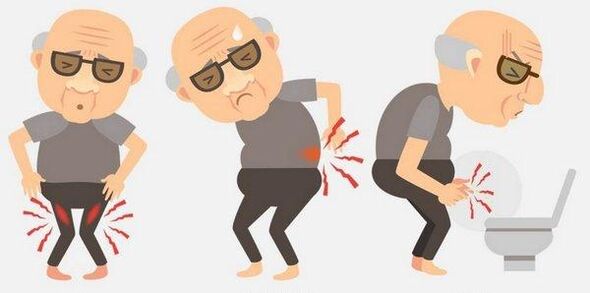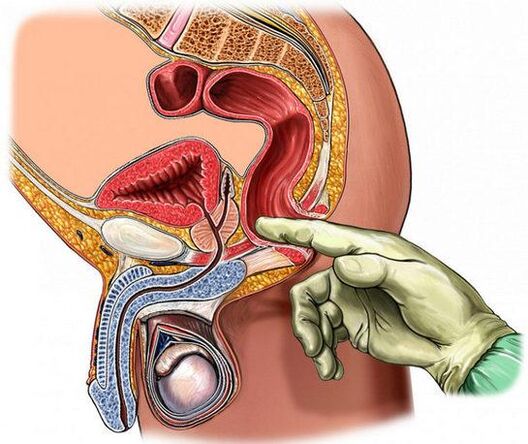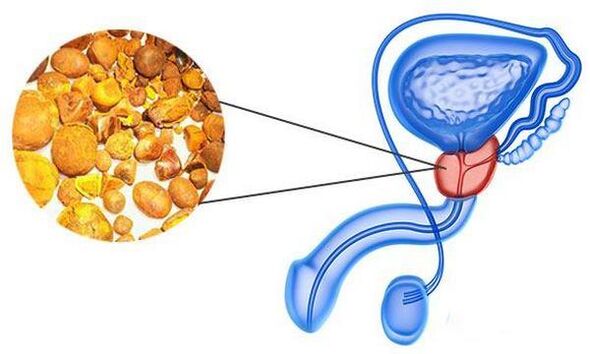The symptoms of prostatitis depend on the shape and causes of inflammation of the prostate gland, as well as the presence of concomitant diseases. Symptoms often cross, which significantly complicates the diagnosis.

Chronic prostatitis
Chronic prostatitis develops as an independent disease or as a complication of the acute form of inflammation. During the remission, the symptoms are weak or completely absent, with exacerbation they become more pronounced. The clinical image resembles acute prostatitis.
The first symptoms of the chronic inflammation form:
- Frequent urgency to urinate;
- Stupid pains at the bottom of the abdomen;
- Switching in the prostate area (area from testicles to anus) with a long stay in the sitting position. Subsequently, sitting for more than an hour is impossible due to the burning;
- Intermittent and painful urination;
- Opaque pain in the rectum during defecation;
- The deterioration of an erection, discomfort in groin during ejaculation is possible.
The previous signs in the chronic form of prostatitis are not manifested at the same time. Initially, this can be a lubricated orgasm, premature ejaculation, then a man has to tense during urination, the pain gradually binds.
In an ultrasound with chronic inflammation, there is a decrease in the density of the prostate tissues, a greater degree of reflection of the fabric wave. In some places, it decreases in the presence of cysts or intensifies in the places of exposure to calcinates (stones), spothetic spotlights (sealing of the connective tissue, formed due to recovery processes after acute inflammation). In the last stages of the foci of connective tissue and fibrosis, there are more and more. The size of the prostate gland is reduced. During the visual diagnosis, it is already difficult to distinguish it from the surrounding fiber.
Acute prostatitis
The acute form of infectious (bacterial) prostatitis is characterized by rapid development. The severity of the symptoms depends on the degree of damage to the gland. With a catarral form (inflammation affects only ducts), a man can only feel a slight discomfort during stress of the inguinal region. During an iron exam, it increases slightly and almost painless.
Folicular (purulent inflammation of the individual fragments of the gland), the parenchymal forms (inflammatory lesion of all the prostate tissues) and the abscess (capsules with purulent content are formed) are manifested by a complete symptoms complex:

- Strong shot in the groin, giving the rectum, testicles, sacred, in the interior hips of the hips, in the penis.
- Fever, general weakness. The active pathogen development causes body poisoning with inflammatory products.
- To the reluctance when urinating, an incomplete emptying of the bladder (due to the irritation of the sphincters and the urethral mucosa).
- Purulent discharge of the urethra (the pus leaves the prostate ducts, opening towards the urethra).
- Feeling of gravity in the perineum.
- Rapid beat attacks.
- Worm urine with purulent threads. Blood may appear.
With a parenchymal form of prostatitis, painful cramps and pulsating pain in the rectum make it difficult to defecate. The little relief occurs only in a pose that is with pressed legs. Often, the inflammation of the prostate extends to the rectum, then the mucus begins to be extracted from the anus. The urination against the bottom of a parenchymal form can stop completely due to the severe edema of the gland.
External signs of acute ultrasound prostatitis:
- Expansion of venous plexus. The vascular pattern is expressed more clearly;
- Expansion of the ducts and capsule of the gland (swelling, unequal increase, stabbing of contours);
- Greater degree of wave reflex with fabric;
- Seed bubbles on the sides of the prostate are asymmetric due to the heterogeneous filling, the ducts that eliminate the seed expand.
With suspicious neoplasms, MRI or CT is prescribed.
Stagnant prostatitis
Prostatitis stagnation (it is also called bacteria in the absence of infections) can develop in young and advanced men. The main symptoms are similar to infectious chronic inflammation. A distinctive characteristic is that the discomfort of the urinary system is manifested and improves mainly due to long -term sexual abstinence. An exacerbation can cause a violent extension of sexual relations, an orgasm does not core (sex without adequate emotional coloration). Painful (wandering) urination is generally observed in the morning. However, if the previous day it was a complete orgasm, there are no cramps.
With this type, prostatitis is the amount of leukocytes in the secret of the gland does not exceed the norm, there is no pathogenic flora in the third portion of urine.
Calcula prostatitis
Calcula prostatitis has no specific symptoms. The very presence of stones (calcined) in the gland does not mean the automatic development of its inflammation. With physical effort, background pains can be intensified. The migration of stones through the ducts sometimes causes the appearance of blood in the urine.
During an ultrasound from the prostate, calcineous are detected. Due to the increase in density, the waves issued by the device are more effectively reflected.
Characteristics of the manifestation of prostatitis in young and mature age

The symptoms of several forms of prostatitis do not depend on the age category of a man. Young people actively live sexual life, so they often develop an acute form of infectious inflammation with the corresponding pronounced signs.
Chronic prostatitis is diagnosed in men a few years after the beginning of sexual activity. During this time, due to the activity of hidden infections, the structure of the prostate is violated, its cellular immunity is reduced. Symptoms appear at a time when pathological changes are already irreversible.
Mature men mainly suffer from urination disorders, stupid newspaper in the perineum and erection disorders. Lick prostatitis at this age is aggravated by stagnant processes in the pelvis in the context of the androgen failure and the loss of muscle tone.
When and to whom to contact
Any of the above symptoms is the reason to contact the urologist or in Andrologist (diagnosis of prostatitis in clinical and domestic conditions). Many men avoid going to the doctor due to a negative attitude to examining the prostate with one finger through the anus or trusie (transrectal ultrasound). If the patient categorically rejects this type of studies, the doctor will offer transabdominal ultrasound, when the sensor is supported against the lower part of the abdomen. The bladder must be filled (it only drinks 350 ml of liquid one hour before the procedure).
Based on the ultrasound results, the doctor determines the nature of the tissue injury of the prostate that surrounds its tissues and the bladder. To identify the cause of inflammation, it is necessary to pass urine, blood, prostate secret (it needs rectal gland massage), in some cases and a sperm.
What diseases have similar symptoms?
Many diseases have symptoms similar to prostatita. First, it is cystitis (inflammation of the bladder). It is characterized by a frequent impulse to the toilet, staining at the bottom of the abdomen, pain during urine, muddy urine, sometimes with blood. Maybe a slight increase in temperature.
In men over 45, with prostatitis symptoms, gland and gland cancer are mainly excluded. Inflammation in the context of these pathologies is often a secondary sign. The symptoms of gland cancer are similar to manifestations in a chronic form of prostatitis: periodic urine disorders that pull pain in groin. The prostate is painless with a finger study, but dense nodes are found in its structure.
The distant night urine, a slow flow of urine, an incomplete emptying sensation of the bubble, the leakage of drops of the urethra and the heaviness in the perineum are characteristics of adenoma. The image is clarified by palpation and ultrasound: the contours of the prostate are preserved, the consistency is elastic, the surface is smooth, the iron is almost painless.
Urinary and groin pain disorders can occur with non -infected prostate calculations: calcined are present, but around it there is no favorable environment to join pathogens. The discomfort in the perineum in this case causes physical activity, ejaculation. With the feeling of a prostate under the fingers, you can feel curtaining (crunch of stones), the body of the gland is dense, tuberous, moderately painful.
Urination disorders, characteristic of the chronic stage of the disease, are also characteristics of the sclerosis of the bladder sphincter (obstacle through the urethra in the form of protrming muscle). La patología es a menudo el resultado de la próstata prolongada. En hombres menores de 40 años, rara vez se diagnostica.
Para la prostatitis crónica, a menudo se toman ganglios venosos expandidos (hemorroides internas). Solo se pueden encontrar utilizando una herramienta de diagnóstico especial. Symptoms:
- Dolor en el ano, dando al sacro y la entrepierna;
- Violaciones de erección;
- Strengthen pain in the rectum and perineum during defecation or prolonged finding in a sitting position.
The contours and the consistency of the prostate do not change. In their secret, pathological changes are absent.

The pain in the area of the anus and the perineum occurs with proxy - inflammation of the rectum. A characteristic feature is a strong ardor sensation in the anus during and after defecation, giving the penis and the crotch. There is a frequent urgency of urinating (every 20-30 minutes) followed by the Lacus urine. Prozatita often develops simultaneously with prostatitis. In this case, parallel therapy for both diseases is necessary.
Prostatitis symptoms also manifest with tuberculosis of the gland. In the risk zone of a man from 20 to 40 years. In the initial development stages, the disease is almost asymptomatic. Occasionally, minor pains are produced in the rectum and perineum. Urine violations begin in the context of participation in the pathological process of parts of the gland, communicating the channel that emits urine.
With tuberculosis, purulent cavities are formed in the body of the prostate. When they break, the content flows to the urethra and frees itself from the penis during defecation. The bacteria that have fallen into the ureter irritate the mucous membrane, cause a quick and painful urination. Through the fiber, the pus can be extended to the rectum. In this case, there is an increase in temperature, weakness, sweating, weight loss.
Conclusion
The prostate gland through the nerve plexus is closely associated with other pelvic organs, whose inflammation gives prostatitis symptoms. The doctor must differentiate (distinguish) prostatitis from other diseases and identify related. The patient should not surprise the fact that with prostatitis symptoms, the exam is directed not only to iron, but also to other organs, in particular, to the rectum. It is important to exclude your participation in the formation of pain and urination disorders, otherwise, the treatment will be ineffective.























